
. "• 2> rhombifolia (Nutt.): leaves petioled; leaflets obovate-cuneiform,
silky-puberulent, at length nearly glabrous; stipules ovate or cordate, acute,
as long Us the_petioles ; flowers alternate or geminate; bracts oval, shorter
than the pedicels; calyx short; the teeth triangular, acute, the upper one
2-toothed; legumes elongated, falcate, pendulous, glabrous.—Nutt.! gen. 1.
P- 283 (under Thermia); Richards, appx. FrankL joum. ed. 2. p. 13 ; DC. !
prodr. 2. p. 99; Hook. fl. Bor.-Am. 1. p. 128, t. 47. Cytisus rhombifolius,
Pursh, ft. 2. p. 741.
Near Fort Mandan, Missouri, Bradbury, Nuttall! Plains of the Platte,
Dr. James! Nuttall! About the Saskatchewan, Richardson Ac. and in the
Rocky Mountains, Nuttall. May.—Flowers smaller than in T. lanceolata,
which the species resembles, yellow. Legumes about 3 inches long, here
and there narrowed by the abortion of the seeds, but not articulated.
3. T. fabacea (DC.): leaves petioled; leaflets broadly oval; stipules
broadly ovate, obtuse, shorter than the petiole; flowers alternate. DC. 1. c. ;
Hook. 1. c. Sophora fabacea, Pallas, Astr. t. 9 0 ,/. 2.
Near the sources of the Utalla and Wallawallah, in the vallies of the Blue
Mountains of Oregon. Douglas.—Found by Pallas in Kamtschatka. We
are wholly unacquainted with this species. Hooker remarks that his specimen
under this name has the leaves thrice as large, and the peduncles thrice
as long as in the preceding species.
4. T. montana (Nutt.! mss.) : “ somewhat silky-pubesent, at length glabrous;
leaves petioled; leaflets lanceolate, narrowed at the base; stipules
oblong-ovate, scarcely longer than the petioles; flowers alternate or sometimes
geminate, subsessile; teeth of the calyx very short; legumes linear, erect,
nearly straight, silky, at length nearly glabrous.
“ High vallies of the Rocky Mountains, in bushy places by streams, near
the line of Upper California. June.—A showy species, with a spike of bright
yellow flowers 3—4 inches long. Leaflets 1—1*) inch long. Bracts small.
Teeth of the calyx very broad and short, acute, nearly equal.” Nuttall.—
The vexillum is considerably shorter than the wings. Legumes narrow,
about 10-seeded.
5. T, macrophylla (Hook. & Am .): stem angled; the upper portion, as
well as the petioles, calyx, and ovaries, villous; leaves petioled; leaflets
obovate-elliptical, tomentose-pubescent beneath, glabrous above; stipules
large, ovate, acute, longer than the petioles; flowers alternate, on short
pedicels; calyx short; the 3 lower teeth acute, the upper slightly 2-toothed;
legumes oblong-linear, straight, erect, 4-5-seeded.—Hook. Sf A m .! bot.
Beechey, suppl. p. 329.
j3. much less pubescent in all its parts.
California, Douglas!—Leaflets 3-4 inches long. Stipules 1J inch in
length. Bracts rather shorter than the calyx. Legumes nearly 2 inches
long, hairy when young.—In the smoother form, of which the specimens are
in a much less advanced state, the teeth of the calyx are shorter and broader.
50. PlCKERINGIA. Nutt. mss. (not of jour. acad. Philad.*)
Calyx campanulate, somewhat truncate, repandly 4-toothed ; the teeth
nearly equal. Vexillum orbicular, emargniate, plicate in the middle, as
* The genus originally established under this name, in the Journal of the
Academy of Natural Sciences, not being distinct from Ardisia, Mr. Nuttall has
dedicated this plant to the same acute naturalist.
long as the oblong wings: keel-petals distinct, equal and similar to the
wings, straight, obtuse. Ovary on a short stipe, many-ovuled : style
filiform, incurved : stigma minute. Legume unknown.—A low and stout
much-branched shrub ; the branches somewhat spiny. Leaves sessile,
sempervirent, small, 3-foliolate. Stipules none, or very caducous. Flowers
(purple) axillary, subsessile.
P. montana (Nutt.! mss.)
“ Summits of the mountains in the vicinity of St. Barbara, California.—
A low densely branched shrub, spreading horizontally six or eight feet in
extent: branches brownish-gray ; the wood white : the branchlets usually
terminating in stout spinous points. Leaves crowded : leaflets sessile,
scarcely an inch in length, oblong-cuneiform or oblanceolate, thick, slightly
pubescent when young, pale beneath- Flowers solitary in the axils of the
leaves at the extremity of the branches, about the size of those of Baptisia
tinctoria. Calyx short, very slightly toothed. Stamens distinct, somewhat
persistent, equal. Ovary linear, pubescent.” Nuttall.—We have also
specimens from Mr. Douglas’s Californian collection, which, like those of
Mr. Nuttall, want the fruit. Although allied to Anagyris, it probably forms
a distinct genus.
2. Leaves unequally pinnate (simple in Cercis) : trees or shrubs.
(Sophoreae, Benth.)
51. SOPHORA. Z/uhn.; R. Br. in hort. Kew.; DC.prodr. 2 .p. 95.
Sophora & Styphnolobium, Schott; Benth. comm. Leg.
Calyx broadly campanulate, obliquely truncate or somewhat 5-toothed at
the summit, often somewhat turbinate or obconic at the base. Vexillum
obovate or roundish, about the length of the other petals: keel obtuse, nearly
straight, the petals somewhat united below the apex. Ovary nearly sessile,
linear: ovules numerous: style nearly straight or incurved: stigma minute.
Legume moniliform, irfifehiscent, (dry or fleshy,) not winged. Radicle
usually inflexed or incurved.—Trees, shrubs, of sometimes herbaceous plants,
with unequally pinnate leaves. Stipules subulate or none. Racemes
axillary or terminal, sometimes paniculate. Bracts subulate, minute, often
caducous.
§ 1. Calyx campanulate, rarely somewhat turbinate at the base: vexillum
erect or a little spreading, entire or slightly emarginate: stamens not
exserted: legume dry: seeds subglobose, not strophiolate: radicle slightly
incurved: stipules none.—E usophora, Benth.
1. S. tomentosa (Linn.) : arborescent; leaflets 15-19, roundish-oval, very
obtuse, canescently tomentose on both sides (as also the calyx); raceme
terminal, elongated. DC.—Linn. spec. 1. p. 373; Lam. ill. t. 375, ƒ. 2 ;
DC. prodr. 2. p. 95. S. occidentalis, Linn. spec. (ed. 2.) 1. p. 533 ;
Swartz, obs. bot. p. 154. S. littoralis, Schrader; DC. 1. c.
0. truncata: calyx somewhat obliquely truncate, the margin entire; leaflets
tapering at the base, glabrous above when old, canescently tomentose
beneath; vexillum emarginate.